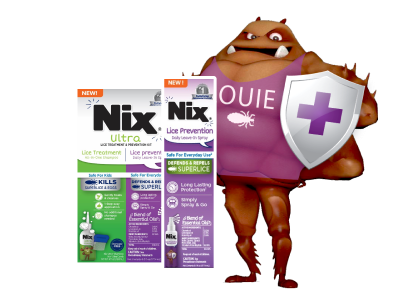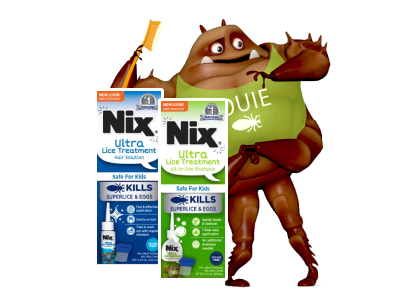
Care for Lice Doesn’t Stop at Head Lice Treatment
Your child came home with lice. You followed the lice treatment steps, used Nix Ultra® Lice Treatment Hair Solution (or a similar lice treatment), and combed out as many lice as you could. You even washed clothing, bedding and followed all directions for killing lice in the home, including using Nix® Lice Killing Spray for the furniture and other items that could not be washed.
Now what?
Steps to Take After Treatment for Head Lice
You may want to do daily lice rechecks to monitor progress and remove any active or dead lice or nits (lice eggs). It is recommended to check hair again after 7 days of using a lice treatment product. If lice or nits are still present, another round of treatment is suggested.
Sometimes lice survive the first round of treatment. This can be a result of not following directions completely or because the lice you are dealing with are harder-to-eliminate superlice that have developed resistance to traditional pesticide lice treatments. If you are dealing with pesticide resistant superlice, you may want to try a pesticide-free product like Nix Ultra® All-in-One Shampoo or Nix Ultra® Lice Treatment Hair Solution.
How often should you do head lice rechecks?
You may want to do head checks daily after the first treatment or when a lice outbreak occurs at school, camp or day care. During every head check, use the special Lice Removal Comb to remove dead lice and nits. If you find dead lice on the first post-treatment head check, this is a good sign. It can’t hurt to check your child’s hair for the next 2 to 3 weeks. Each time, use the special comb to remove nits and lice.
If you are not finding any dead lice and all lice are still active, you may want to treat your child again with a pesticide-free product, like Nix Ultra® All-in-One Shampoo and follow the combing instructions If you have any questions, you can always reach out to your pediatrician or pharmacist with questions.
How will you know when you can stop doing head checks after treatment? If you do 2 or 3 head checks in a row where you find no nits or lice (dead or alive), then you can stop. However, if children in your child’s school, camp or sports team still are dealing with lice outbreaks, then daily head checks are still a good idea to catch any potential reinfestation early.
Should you apply the lice treatment solution or shampoo again?
Yes, you can do a second treatment after seven days if lice are still present. Because a large percentage of lice outbreaks consist of superlice, which are resistant to some treatments containing pesticides, if lice are still present after a second treatment, make sure you are using a pesticide-free product or contact your child’s doctor.
What lice prevention steps should you take with the rest of the family?
Once you find lice on one child, you will also want to do head checks on each family member—and have someone check you—and then check each person again daily until no lice or nits are found.
While you have at least one child with lice, the rest of the family can add a layer of protection by using Nix® Lice Prevention Daily Leave-In Spray until there are no signs of lice remaining on the affected child. The spray is very easy to use and can help prevent lice and superlice.
Make sure everyone in the family knows best practices for preventing lice. This includes not sharing any hair-related items or hats or clothing. No sitting or lying on each other’s beds. No head-to-head contact (e.g., “selfies”). Vacuum rugs and carpets to remove any fallen hair that may still have lice attached.
If you’ve used the Nix® Lice Killing Spray we mentioned earlier—such as on sofa cushions, mattresses and other household items that can’t be washed—the spray kills lice for up to 4 weeks, so there is no need to keep spraying each day.
Is there anything else I should do when my child has lice?
Having lice can be very upsetting and isolating for kids. Teasing or bullying at school or in other group settings may increase. It’s also very easy to feel embarrassed or even guilty for bringing lice home. The stress along with problems sleeping due to itchiness from lice bites can result in a difficult emotional toll.
To help your child with the anxiety or mental stress that lice can bring, continually emphasize that having lice is not their fault. Explain that many children get lice. In fact, in the U.S. each year, 6 to 12 million kids between the ages of 3 and 11 get lice1. Having lice should be seen as similar to having a cold, strep throat, or any other type of illness. You can’t always control whether you get them, but you can take steps to get better and keep them from spreading.
Include your child as a partner in their care as much as their age and maturity allows. Explain the steps you’re taking and how everyone in the family can help prevent the lice from spreading to anyone else. Give them confidence that the lice will go away, and that you are in this together.
It’s important to keep playing with your child, while keeping preventive measures in mind. Card games, board games, tossing a ball outside and other activities can take your child’s mind off the fact they have lice and still make them feel loved and included.
If you notice any significant changes in mental health, contact your child’s doctor right away or ask for resources from the school counselor.



